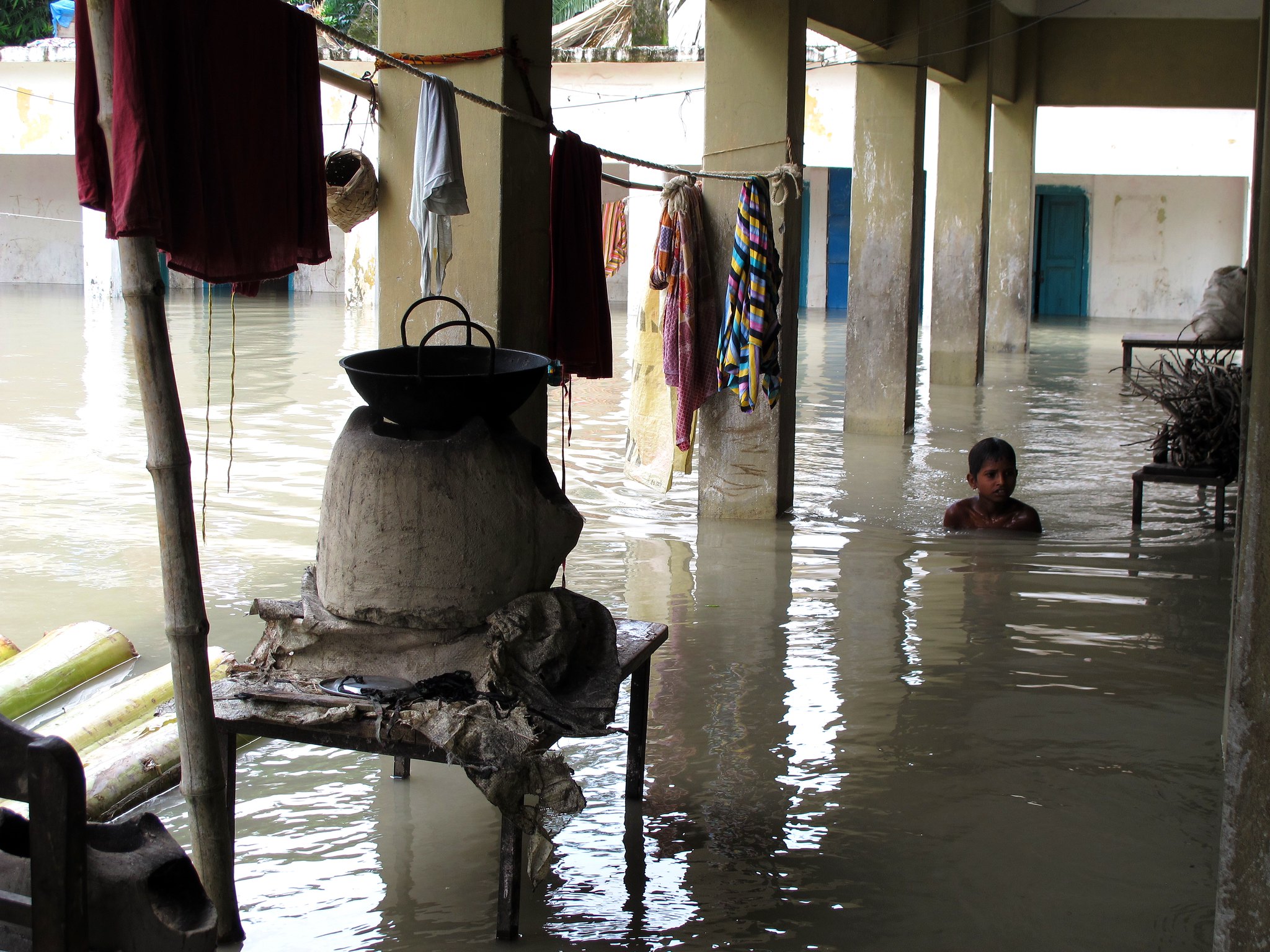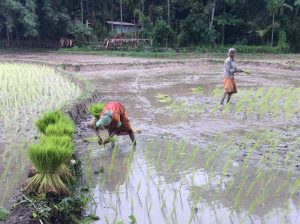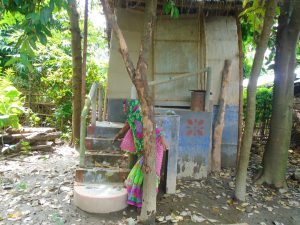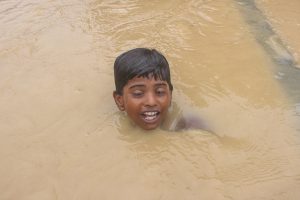The mid-August flooding in Bangladesh this year is severe in nature with over 8 million people affected in 32 out of 64 districts. 700,000 houses have been totally or partially submerged, and over 140 people killed, mostly by drowning. But given the numbers affected, it is also striking deaths by disease have been minimal, an outcome of better equipped health offices in the affected districts that helped the South Asian nation to check the outbreak of diarrhoea, cholera and other water-borne diseases.
Bangladesh experienced disastrous flooding in 1987, 1988, 1989, 1998, 2004 and 2007, causing many diarrhoeal deaths as water-borne diseases spread in epidemic forms in the post-flood period. Meerjady Sabrina Flora, the director at the Institute of Epidemiology, Disease Control and Research (IEDCR) under health ministry, told thethirdpole.net that diarrhoea and cholera were the major diseases reported in the previous floods.
Diarrhoea was a major killer
The American Journal of Tropical Medicine and Hygiene in an article on diarrhoeal epidemics in three most serious floods in Dhaka – 1988, 1998 and 2004 – wrote that vibrio cholera was the most commonly identified cause of diarrhoea followed by rotavirus. In the 1988 flood in Bangladesh, diarrhoeal disease was responsible for 35% of all flood-related illness and 27% of 154 flood-related deaths in a population of more than 45,000 patients in rural Bangladesh.
In the 2007 floods, the death caused by flood-related diarrhoea came down. In its situation report UNICEF reported only 17 out of the 615 flood-related deaths in 2007 were caused by diarrhoea even though 68,862 had it.
“Not seen a single diarrhoeal death”
This year disease related deaths have been even fewer. “The flood hit us on August 12. But we have not seen a single diarrhoeal death. This is really an achievement. It never happened in the previous floods,” Flora said. Although she warned that the risk of water-borne diseases spread in the post-flood period was still there.
Sakhawat Hossain, a medical officer at the emergency control room of the health directorate, told thethirdpole.net that, as of August 27, there was no cholera, no diarrhoea, no epidemic, and no outbreak during floods in any parts of the country.
The civil surgeons’ offices at all districts collect the number of cases of diarrhoea and other diseases and report back to the control room every day.
The heavy torrential rain coupled with bulk flows of the trans-boundary rivers started flooding Bangladesh since August 12. Most of the districts in the country’s northwestern districts are free from floods while some southern and south central areas have been experiencing mild flooding.
“The diarrhoea situation remains the same as we see around the year,” said Hossain, adding that diarrhoea was one of the major diseases in Bangladesh.
“But recent floods have not aggravated the situation. Usually 35% of the patients are affected by diarrhoea in Bangladesh. For instance, today (August 27) we were reported that 1,611 people in the flood affected 32 districts got sick of different diseases. The number of diarrhoea patients is 690,” he said.
SM Aminul Islam, the civil surgeon of Kurigram, one of the districts most affected by flooding, told thethirdpole.net that 23 people died during floods in Kurigram.
“Most of them died by drowning. None of them died of cholera or diarrhoea or other water borne diseases,” he said.
He said around 300 patients were affected by diarrhoea during floods, and the people in his district had been suffering from some nonfatal diseases such as fungal diseases.
“In average, we get 21 diarrhoea patients per day during floods, and the number is quite usual,” he said.
How did Bangladesh manage the turnaround?
Flora attributed the success to the advanced preparation of the government.
She said the district health (civil surgeons’ office) offices, under the guidance of the directorate of health, were better prepared since early July, apprehending probable floods in August.
“We have taken huge preparation to ensure water purification tablets for all flood victims. Bleaching power and other germicides were applied at the flood shelters. Also, the medical teams regularly visited the affected families and the makeshift shelter homes,” said Flora.
Zahid Maleque, the state minister for health, told thethirdpole.net that the government launched massive campaigns, warning people about the water-borne diseases.
“The people irrespective of their economic status now know that oral saline solution can cure diarrhoea,” he said.
Mowla Bux Chowdhury, the civil surgeon in northwestern Dinajpur where 30 people died in seven days of flooding, said that they get five diarrhoea patients per hospital each day.
“97% of Dinajpur town and all 13 upzillas (sub-districts) were affected by the recent floods. But the diarrhoea situation in Dinajpur was normal,” he said.
He said they ensured potable water at the shelter centres.
“Before they went to their houses, we have provided water purification tablets to purify water of the tube wells. Also, we have provided them oral saline apprehending the spread of diarrhoea,” said Chowdhury.
He said the oral saline would enable the people to treat minor diarrhoea at house.
Chowdhury said the family planning department, civil society groups, NGOs, different political parties and cultural groups extended necessary support to contain the probable outbreak of diarrhoea and other water borne diseases.
“Twenty years ago, it was unthinkable that a person from lower middle class family would buy one litre of water costing BDT 10 (USD 0.12). But now even the poor people buy 500 millilitre bottle costing Tk 15 (USD 0.18). This happened because people are conscious about diarrhoea and other water-borne diseases,” Abu Bakar Siddique, a former public analyst at the Institute of Public Health, told thethirdpole.net.
He said a big segment of the society now knows that they need to wash their hands after toilet use with soap, before eating something, a principal vector of cholera spreading.
“Media, especially TV programmes, have played very good role in creating public awareness about basic hygiene,” said Siddique.




![A woman pumps up water from a tubewell in West Bengal despite the red cross that signifies that there is an unacceptable level of arsenic in the water [image by Dilip Banerjee]](https://dialogue.earth/content/uploads/2017/09/Woman-at-tubewell-West-Bengal-Image-by-Dilip-Banerjee-1-300x206.jpg)



![A flood affected resident of Jakhalabandha, Assam on the south bank of the Brahmaputra being evacuated on a raft on August 13, along with the family's livestock [Image by Biju Boro]](https://dialogue.earth/content/uploads/2017/09/Jakhalabandha-flood-300x200.jpg)
